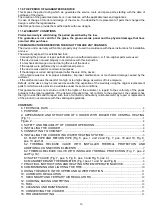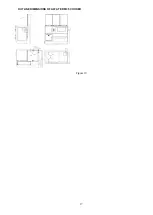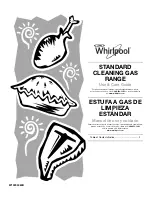
12
on the regulation knob. The cooker power
is regulated by turning the knob ‘’+’’ to increase and the knob ‘’-‘’ to
reduce the power.
In the power regulation system, air regulator (damper) fully controls combustion air supply if other openings are
closed.
Figure 13
11.
SECONDARY AND TERTIARY AIR REGULATORS
Secondary air regulator is placed in the firebox door (Fig. 15). It controls additional lighting of fire and burning of
unburned flue gases. The secondary air is adjusted using the lever on the internal side of the firebox door. On
the internal side of the firebox door, there is a clear marking 0-1. If the lever is moved in 0 direction, the quantity
of the secondary air is decreased, while it is increased if the lever is moved in 1 direction.
Leave the secondary air regulator open when the fire in the cooker is lit.
Behind the rosette cover, there is a tertiary air regulator (Fig. 1, pos. 17). It controls additional lighting of fire and
burning of unburned flue gases. The opening and closing of the rosette cover is done using the lever located
between the lower part of the rosette cover (Fig. 1, pos. 16) and opening cover (Fig. 1, pos. 14).
. The signs ‘’+’’
and ‘’–‘’ are written on the lever. By turning the lever ‘’+’’ you increase tertiary air,by turning it at ‘’-‘’ you can
reduce the air.
Leave the tertiary air regulator open when the fire in the stove is lit.
12. COOKING, BAKING, AND FRYING
During heating season, the cooker is used mainly for heating. For faster baking, cooking and frying, use only dry
firewood.
While baking, the butterfly (Fig. 1, pos. 4) for fire starting has to be closed, the rosette button for heating-baking
has to be in position
“1” (Fig. 13, pos. 19), power regulator has to be open and the stove covers have to be
raised using the key (Fig. 18). After you finish baking, cooking or frying, place the power regulator in desired
position and the rosette button for heating-baking to position
“0”.
While baking, increase the temperature of the water in the system to at least 60
C and, if necessary, close some
of the radiators during baking and adjust the oven temperature to the food being prepared.
13. FUEL
Fuel can be stored in the fuel box (Fig. 17). The fuel box is moved on guides. If you want to take the fuel box out
of the cooker, you must lift it to remove it from the guides.
Use the fuel specified in Table 1 to ensure the nominal heating capacity of the boiler at chimney draft of 25 mbar
(25 Pa).
Do not burn coal dust, sawdust, or waste that generates large quantities of smoke!
Figure 15
Figure 15



































